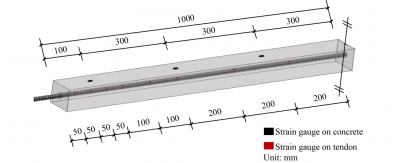Science
New Study Reveals Impact of Freeze-Thaw Cycles on Prestressed Concrete

Research conducted by a team from Xi’an University of Architecture and Technology and Beijing YJK Building Software Co., Ltd. has revealed significant insights into the effects of freeze-thaw (FT) cycles on prestressed concrete (PC) structures. As these materials are increasingly utilized in cold regions, understanding their vulnerability to freeze-thaw damage is critical for ensuring safety and longevity.
The study, titled “Frost Heaving Behavior and Mechanical Deterioration of Prestressed Concrete,” was led by Xiguang Liu alongside researchers Huimin Zhang, Yao Lv, Ditao Niu, and Jingxi Peng. It specifically investigates the frost heaving behavior and mechanical deterioration of bonded post-tensioned PC components subjected to various FT conditions.
Eight bonded post-tensioned PC components were designed and manufactured with stress levels of 0.1, 0.2, 0.3, and 0.4. These components underwent a series of experiments, experiencing between 0 and 300 FT cycles. The research focused on measuring strain variations along the length of the components throughout the cycles, providing valuable data on how FT conditions affect concrete performance.
The findings indicate that as the number of freeze-thaw cycles increases, both the concrete frost heaving strain and the residual strain escalate, leading to a notable loss of prestressing tendon strain. At lower stress levels, the prestress tends to inhibit cracking in the concrete. However, when stress levels exceed a certain threshold, the risk of frost damage intensifies, posing a significant threat to structural integrity.
Implications for Design and Maintenance
To better understand these interactions, the research team developed a strain loss model that correlates well with the experimental results. This model can serve as a critical tool for engineers and architects involved in the design and maintenance of PC structures in cold climates.
The study highlights the necessity for ongoing research and development of strategies to mitigate freeze-thaw damage. As the demand for durable infrastructure increases, findings like these will inform best practices and contribute to safer building techniques in regions susceptible to harsh weather conditions.
The full text of the paper is available at: https://doi.org/10.1007/s11709-025-1188-1.
-

 Technology5 months ago
Technology5 months agoDiscover the Top 10 Calorie Counting Apps of 2025
-

 Health2 months ago
Health2 months agoBella Hadid Shares Health Update After Treatment for Lyme Disease
-

 Health3 months ago
Health3 months agoErin Bates Shares Recovery Update Following Sepsis Complications
-

 Technology4 months ago
Technology4 months agoDiscover How to Reverse Image Search Using ChatGPT Effortlessly
-

 Technology1 month ago
Technology1 month agoDiscover 2025’s Top GPUs for Exceptional 4K Gaming Performance
-

 Technology2 months ago
Technology2 months agoElectric Moto Influencer Surronster Arrested in Tijuana
-

 Technology5 months ago
Technology5 months agoMeta Initiates $60B AI Data Center Expansion, Starting in Ohio
-

 Technology5 months ago
Technology5 months agoRecovering a Suspended TikTok Account: A Step-by-Step Guide
-

 Health4 months ago
Health4 months agoTested: Rab Firewall Mountain Jacket Survives Harsh Conditions
-

 Lifestyle5 months ago
Lifestyle5 months agoBelton Family Reunites After Daughter Survives Hill Country Floods
-

 Technology4 months ago
Technology4 months agoHarmonic Launches AI Chatbot App to Transform Mathematical Reasoning
-

 Technology3 months ago
Technology3 months agoUncovering the Top Five Most Challenging Motorcycles to Ride













